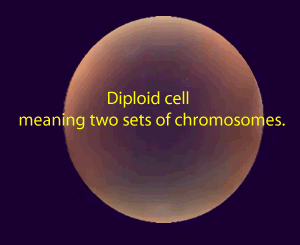Meiosis is the process by which animals produce gametes (egg and sperm cells) and plants produce spores for sexual reproduction.
Although the process of meiosis is very similar to mitosis there remains two distinct differences.
1) In meiosis the genetic material in chromosomes is reshuffled producing chromosomes with new combinations of genes. In mitosis, chromosomes are faithfully reproduced.
2) Mitosis produces two daughter cells with identical genetic material to the parent cell, while meiosis produces four daughter cells containing unique genetic material and half the number of chromosomes of the parent cell.

The different stages of meiosis are summarised on the left

The process of meiosis involves two nuclear divisions labelled Meiosis I and Meiosis II. Meiosis 1 is sometimes referred to as Reduction and Meiosis II is referred to as Division. These steps are further subdivided,as shown on the left, into a number of distinct stages. For example Meiosis 1 is divided into:
Interphase 1 - DNA is copied.
Prophase 1 - During this stage, homologous chromosomes link together to form structures of four chromatids, known as tetrads. During prophase homologous chromosomes may exchange genetic material in a process called crossing-over. Crossing-over results in the formation of recombinant chromosomes with new combinations of genes.
Metaphase 1- During this phase tetrads line-up along the equator of the cell. Spindle fibers attach to the centromere of each homologous chromosome pair.
Anaphase 1 - During this phase the tetrads separate, and are pulled to opposite poles by the spindle fibers. The centromeres in Anaphase I remain intact
Telophase 1 The cell membrane now pinches off and in some species a nuclear membrane reforms.
Prophase 2 - During this stage nuclear envelopes dissolve and spindle fibers reform.
Metaphase 2 - Here, chromosomes move into the centre of the cell where spindle fibres attach to each chromatid.
Anaphase 2 - The chromosomes are pulled apart and each chromatid is pulled to opposite sides of the cell.
Telophase 2 - This stage is identical to telophase of mitosis.
1) Why is Meiosis 1 referred to as Reduction?
2) Why is Meiosis 2 referred to as Division?
3) What are the main differences between Mitosis and Meiosis?
4) i) What is a recombinant chromosome?
ii) Explain how a recombinant chromosome comes about.
5) Define the terms:
- diploid,
- haploid,
- zygote,
- somatic cell.
6) What is the advantage of Meiosis over Mitosis in the production of egg and sperm cells for sexual reproduction?
7) A cell enters prophase with a diploid number of 24. How many tetrads are found?
Look at the video on the right and answer the questions below.
8) What is a homologous chromosome?
9) What does the term Crossing-over refer to?
10) Explain why each of the four haploid daughter cells a genetically unique.